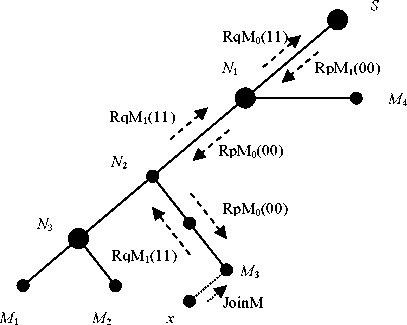by changing the value of S bit to zero and forward the updated message (RqM0(11)) to the
source.
The source upon receiving this message will create and send a reply message (RpM1(00))
towards the x’LMR to confirm that the joining of the new receiver (x) is accepted.

Figure 4.8 Joining process in SReM (Case 3)
|
Nodes |
MFTs | |
|
S (Source) |
MTI | IP_V1 |
unchanged |
|
V1 |
MTI | IP_V3 &IP_M4 |
MTI | IP_V2 &IP_M4 |
|
V2 |
— |
MTI | IP_V3 & IP_M3 |
|
V3 |
MTI | IP_M1 & IP_M2 |
unchanged |
Join message
RqM or RpM
eBNM or rBNM
In this case, N1 will discover that the new receiver (x) is connecting through an LMR where
this LMR is not in N1 MFT entry. In this case, changes in the multicast tree should happen; a
new branching node should be added to the multicast tree. In other words, tree maintenance
should take place because of this new receiver joining case. Because the tree maintenance
process is an important issue in SReM, it will be discussed later in a separate section in this
chapter.
4.4.3 Leaving process in SReM
The receiver that wants to leave the multicast group starts by sending a leaveM messages to
the LMR connecting this receiver. Different cases of leaving process may happen depending
on the tree structure and whether or not the leaving member is the last member attached to
the LMR. These expected cases are:-
■ Case 1: the leaving member is not the last member connected to the LMR.
69
More intriguing information
1. The name is absent2. The Role of Immigration in Sustaining the Social Security System: A Political Economy Approach
3. Studies on association of arbuscular mycorrhizal fungi with gluconacetobacter diazotrophicus and its effect on improvement of sorghum bicolor (L.)
4. Fortschritte bei der Exportorientierung von Dienstleistungsunternehmen
5. The mental map of Dutch entrepreneurs. Changes in the subjective rating of locations in the Netherlands, 1983-1993-2003
6. A MARKOVIAN APPROXIMATED SOLUTION TO A PORTFOLIO MANAGEMENT PROBLEM
7. The name is absent
8. The name is absent
9. Artificial neural networks as models of stimulus control*
10. The Mathematical Components of Engineering